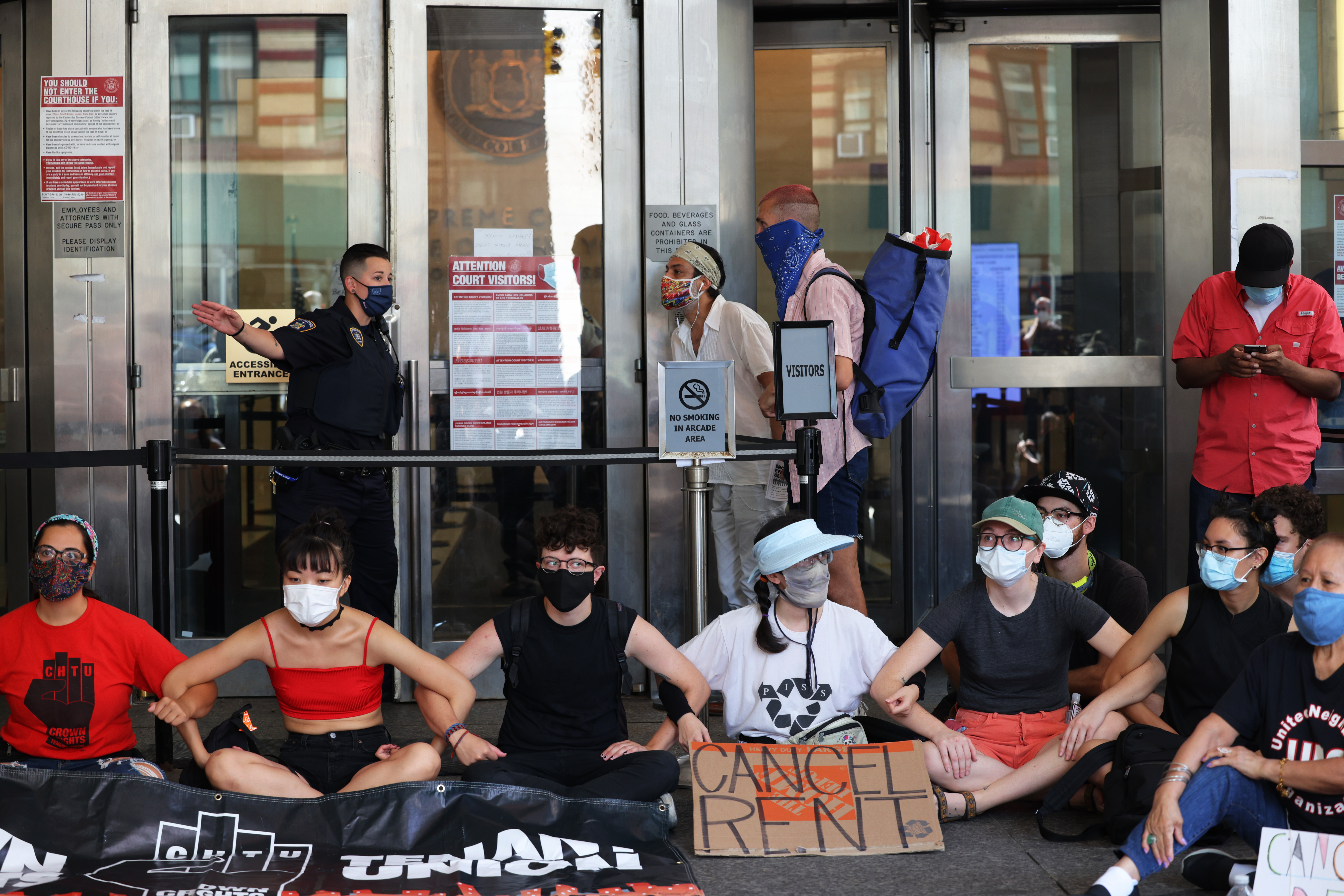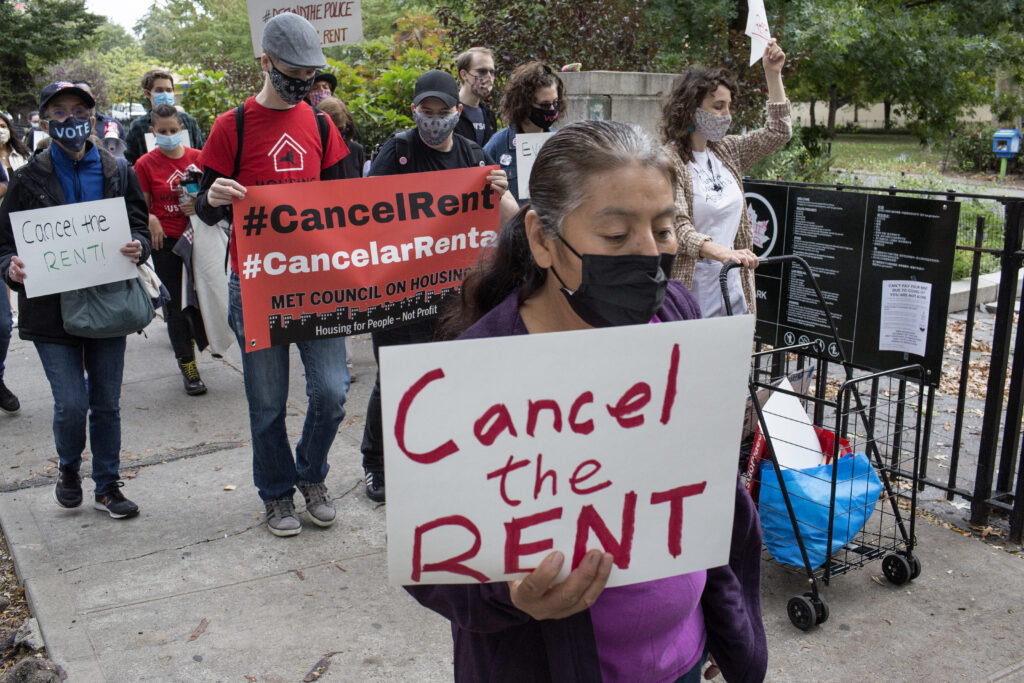This article is part of our series “On the Precipice: A Progressive Agenda in the Biden Era.” Download a PDF of the full series here.
When president-elect Biden moves into his new Washington DC home in late January, an estimated 30 million people in the U.S. will be in danger of losing theirs. As the pandemic engulfed the U.S. over the past year, greater housing insecurity emerged as both a byproduct of this public health crisis, and yet another factor propelling Covid’s spread. Black and Latinx renters in particular are facing mounting levels of rent debt and the looming threat of eviction.
The pandemic represents a sudden shock to an overburdened system, after decades of deregulation, budget cuts, and overall federal withdrawal from housing provision. Before the pandemic began, there was no state, metropolitan area or county in the U.S. where a minimum wage worker was able to afford a decent two-bedroom apartment. Nearly 570,000 people were homeless. With the long-term economic impact of the pandemic, these figures are likely to dramatically expand in 2021.
Federal housing policy has withered under a stringent austerity regime over the past four decades. However, in 2020, racial and economic justice movements pushed Democratic presidential candidates to develop responses to the U.S.’s housing crisis. Both the Biden and Harris campaigns proposed spending billions of dollars on housing programs, an ideological shift for the Democratic party. However, their proposals are also indicative of a continuing commitment to market-based solutions and minor legal reforms, which are unlikely to meet the scale of crisis at hand, or address structural issues within the housing market that reproduce racial inequality.
At the same time, the U.S. is seeing a resurgence of housing centered organizing, pushing away from incrementalism and toward a complete overhaul of housing, as said by Tara Raghuveer of Kansas City Tenants. With Democrats winning slim control over the federal legislative branch, Biden’s administration will have to respond to growing local organizing around key housing issues, like eviction and homelessness.

Federal housing policy, from Reagan to Trump
Biden’s approach to housing should be viewed in the context of budget and policy decisions made by preceding federal administrations. Over the past four years, the Trump administration attempted to punitively impose racist, transphobic and anti-immigrant measures throughout the whole state apparatus, excluding transgender people from housing assistance, targeting undocumented immigrants receiving housing subsidies, and rescinding federal laws addressing racial discrimination. Trump’s proposed housing spending cuts were less successful, largely as a result of anti-austerity mobilizations by housing organizers. However, decades before Trump’s election, the U.S. federal government cut funding, weakened regulations and generally withdrew from low-cost housing provision.
Deep cuts to social safety net spending, including housing programs, accelerated under the Reagan administration (1981-1988), propelled forward by an interconnected ideological commitment to anti-communism and white supremacy. In 1981, a spokesperson for the U.S. Department of Housing and Urban Development (HUD), the federal agency that oversees housing programs, made clear that “the whole attitude that the federal government can solve all the housing problems of this country-those days are over.” The administration proceeded to make deep cuts to the main housing programs of the time, including public housing, which provided funding for new development and the ongoing operations of housing subsidized directly by the federal government, and Section 8, which provided rental housing assistance to private landlords on behalf of low-income households either in project-based form, or in the form of vouchers. Reagan cut the HUD budget by three-quarters, from $32 billion in 1981 to $7.5 billion by 1988.
While slashing federal housing assistance, the Reagan administration also sidelined and ignored federal anti-discrimination laws hard won by civil rights organizers. These laws included the Fair Housing Act of 1968, which provided the legal basis for challenging racist lending and real estate practices, and the Community Reinvestment Act of 1977, which incentivized mortgage lending in low- and moderate-neighborhoods as an antidote to redlining, or what scholar David Imbroscio calls “the codification of racist market rationality”, especially anti-Blackness, by the federal government and private mortgage lenders. The Reagan administration described its drive to “unleash the free market” through budget cuts and weakening regulation over the lending and real estate sectors in race-neutral terms. However, the property market is not a force of nature but rather, according to scholar and activist Keeanga-Yamahtta Taylor, “a reflection of our values”, with “race is at the very center.” Overall, these federal rollbacks were a revanchist drive against gains made by organizers in the previous decades.
After Reagan, federal housing spending continued to wither under both Republican and Democratic administrations. In 1996, the same year that President Bill Clinton promised to “end welfare as we know it”, the New York Times Magazine lamented that “protesters hit the streets during the early years of Ronald Reagan’s presidency when the government slashed the number of new families getting [rental assistance] help to 40,000 a year, from previous highs of about 400,000. Oh, for the good old Reagan days: the bill that President Clinton signed last month drops the number to zero.” President George W. Bush’s lavish tax cuts and military expenditures early in his presidency led to a budget deficit, which justified later cuts to affordable housing programs. During the Obama administration, a national debt-ceiling crisis, manufactured by a further emboldened Republican party, acted as a justification for reductions on all social safety net spending through 2021, including reductions to public housing and rental assistance.
With a stringent, four decade austerity regime as a backdrop, federal support of the mortgage market–both in the form of bailouts to lending institutions in times of crisis and ongoing subsidies to landlords and wealthy white homeowners–has ballooned. Many of these subsidies are delivered through the tax code and are largely hidden from both public scrutiny and from the annual federal budgeting process, where cuts to social safety net programs get made, cementing the idea of a racialized welfare recipient and a race-neutral property market.
Where is federal housing policy headed in 2021?
Federal housing policy came into focus during the 2020 Democratic primary, as local organizers from racial and economic justice movements pushed presidential candidates to develop responses to the U.S.’s housing crisis. While campaign proposals are only a rough guide to the policies that presidential administrations actually enact, the Biden and Harris campaigns’ housing plans provide insights into their overall priorities. Both committed to spending billions of dollars on housing programs, a first since the late 1960s. This, within itself is an ideological shift left for the Democratic party, and an expansion above the baseline set by preceding administrations. However, both plans largely rely on existing affordable housing programs without addressing their flaws, and do not grapple with structural issues within the U.S. housing market. Below, I outline some of the major policies put forward by both campaigns, and provide examples of proposals from both inside and outside the electoral landscape to strengthen them.
Housing Production
A central aspect of Biden’s housing plan is the expansion of existing affordable housing production programs, including an annual $10 Billion allocation of funding for existing state block grant programs and homelessness assistance grants. This figure includes a $2 Billion commitment to the National Housing Trust Fund, an eight-fold increase in funding for the first new federal housing program in over 40 years to explicitly serve extremely low-income renters. While this is an ambitious increase in federal funding for affordable housing production, it pales in comparison to both historical precedent set by the New Deal and Great Society funding commitments, and competing contemporary housing proposals, like Bernie Sanders’ $148 billion a year commitment to the National Housing Trust Fund.
Biden’s housing plan ignores U.S.’s embattled public housing stock, the federal program that provides permanent housing to low-income renters with deepest levels of affordability, covering about 1.2 million apartments. There are multiple proposals that address the public housing funding deficit resulting from federal budget cuts, including Representative Nydia Velázquez’s Public Housing Emergency Response Act that would allocate $70 billion for capital repairs and Representative Alexandria Ocasio-Cortez’s Green New Deal for Public Housing Act, which would commit up to $172 billion over ten years to green retrofits.
While public housing represents just one program in a constellation of federal housing policies, its systematic destruction is symbolic of a federal commitment to market-based solutions that privilege the needs of investors and landlords in program design over the social functions of housing. This market bias continues to shape the structure of federal housing programs, often resulting in the privatization of public benefits at the expense of low-income people. A recent example are the federal programs that incentivized Wall Street investment in foreclosed homes, giving rise to the single family home rental market dominated by corporate landlords in the wake of the 2008 mortgage crisis.
Over the past few years, both organizers and elected officials have put forward proposals that not only call for a major increase in federal housing spending, but intentionally set the groundwork for a broader federal housing program reorientation toward the social functions of housing. For example, the People’s Action’s Homes Guarantee campaign has called for the development of 12 million homes outside of the speculative housing market. The related Homes for All Act, introduced by Representative Ilhan Omar, would authorize the construction of 12 million new public and social housing units, while making public housing a mandatory part of the federal budget, thus making it more difficult to defund. At the same time, the Movement for Black Lives’ policy platform calls for federal support for institutions that build Black community wealth, including residential cooperatives and land trusts, while the Urban Democracy Lab’s Social Housing Development Authority (SHDA) proposal would create a new agency to acquire and rehabilitate distressed housing. These proposals would go a long way toward reorienting the type of housing production federal policy supports.
Rental Assistance
Along with more federal subsidies for housing production, Biden and Harris have both called for an expansion of rental assistance. Biden proposed to expand the federal Housing Choice Voucher Program, also known as Section 8. Under Section 8, the federal government provides direct assistance to low-income tenants to pay for part of their rent in private apartments. Currently, only one in four income-eligible families receives a voucher, but Biden’s plan would increase funding so that every eligible family could be served. During her campaign, Harris also put forward a plan that would provide rent assistance in the form of an income tax credit for families with somewhat higher incomes who nevertheless pay unaffordable rents.
Scholars and activists have long critiqued the Section 8 voucher program for reinforcing segregation, transferring public wealth into private hands, and inflating rents. Biden’s housing plan incorporates some legal provisions that address Section 8 critiques, including a law that would make it illegal for landlords to discriminate against voucher holders in the tenant selection process and a program that would help tenants facing eviction access legal assistance. However, these provisions do not go far enough to limit the potential for rent inflation and mitigation of bad landlord behavior. To prevent landlords from hiking up rents, the federal government should implement a national rent control standard and additional eviction protections, as outlined in Bernie Sanders’ campaign proposal. Further, rent assistance payments should be tied to increased enforcement of housing codes, tenant protections, and anti-harassment statutes.

Vouchers, in essence, are a method for providing ongoing operational assistance for the buildings in which their recipients live. Within the context of our contemporary rental market, this means that they help private landlords generate profit and expand their real estate portfolios. However, if paired with an expansion of a social housing sector, they can provide support for the ongoing maintenance of the social function of housing.
Lastly, a rental assistance program will do little to help with a catastrophic looming rental debt crisis, set off by the pandemic. Rental assistance should be preceded by a rent debt jubilee as described by one of the Los Angeles Tenants Union founders in a recent The Nation piece.
Racial Equity
The Biden and Harris campaigns both acknowledged the role the federal government played in exacerbating segregation and widening the racial wealth gap through housing and lending policy. Both promised to reinstate legal anti-discrimination tools scuttled by the Trump administration, including the implementation of the Affirmatively Furthering Fair Housing Rule, a 2015 mandate requiring municipalities to study and mitigate housing segregation. Both campaigns also planned on using the federal government’s power to enforce settlements against discriminatory lenders, a practice stopped by the Trump administration.
While Biden’s housing plan acknowledges the pervasiveness of racial discrimination in real estate, it stop far short of using the federal government’s full power to challenge racist real estate practices by local governments and lending institutions. For example, Biden calls for the elimination of exclusionary zoning, or local land use ordinances that ban the development of apartment buildings and otherwise allow wealthy white localities to reinforce segregation, without running afoul of the Fair Housing Act. Biden’s plan calls for states receiving federal housing and transportation funding to merely develop strategies to encourage inclusionary zoning, a weak gesture against exclusionary zoning without enforcement mechanisms.
Biden’s plan also calls for a national standard for housing appraisals, linking the undervaluing of Black neighborhoods to “implicit biases because of a lack of community understanding,” ignoring the explicit codification of what housing expert Charles Abrams, called the “racist theory of value” into the property appraisal system during the professionalization of the modern real estate industry in the 1920s.
Access to homeownership is central to both the Biden and Harris proposals, with Harris calling for a $100B down payment assistance program for people renting or living in historically redlined communities, with the explicit goal of addressing the racial wealth gap. While an expansion of federal down payment assistance isn’t within itself bad policy, it is unlikely to address the racial wealth gap on its own. It is focused on what historian Destin Jenkins calls “disparities in the acquisition of wealth”, rather than “racial disparities in the defense of wealth: the relative ability to defend wealth from expropriation, whether through violence, state-sanctioned seizure, and sometimes both.” The U.S. real estate and lending markets continue to expose both Black homeowners and Black renters to greater levels of risk, including subprime mortgages, discrimination by insurers, and deed theft in gentrifying neighborhoods. A policy organized around the defense of Black wealth should both regulate and hold accountable existing private institutions that continue to profit off a segregated housing market.
What’s possible?
The housing proposals put forward by the Biden and Harris campaigns are both a sign of shifting priorities within the Democratic party, and are indicative of its limitations. Further, the tepid response from the party’s leadership to a looming eviction crisis shows how far the U.S. is from a major commitment to social housing or from dismantling racist lending institutions.
At the same time, the conservatism of the Democratic party’s leadership is not within itself an indication that change isn’t possible. Looking back on the Lincoln, Roosevelt and Johnson presidencies, labor organizer Bob Master writes that it was “a combination of crisis and mass movements that transformed these presidents, pushing them to enact far-reaching policies that were unimaginable at the beginning of their tenures.” With control of both the legislative branch and the presidency, the Democratic party is in a position to meaningfully respond to the U.S. housing crisis.
2020 election results locally show that bold housing initiatives are likely to be popular with the general public. For example, voters in Denver approved a .25% sales tax increase to fund homeless services, and voters in Charlotte, NC passed a $50 million bond issue for the Charlotte Housing Trust Fund. Grassroots groups across the U.S., in Kansas City, Philadelphia, Chicago, and Los Angeles, are already successfully mobilizing around housing. Ultimately, Biden’s approach to the housing crisis will depend on the ability of an energized mass movement centered around racial and economic justice to put pressure on the Democratic party to take bold steps like forgiving rent debt, holding leaders accountable, or passing the Green New Deal for public housing.
Oksana Mironova is a writer and researcher who was born in the former Soviet Union and grew up in Brooklyn, NY. She writes about cities, urban planning, housing, and public space. You can follow her on twitter @OksanaMironov or read more of her writing at oksana.nyc.



